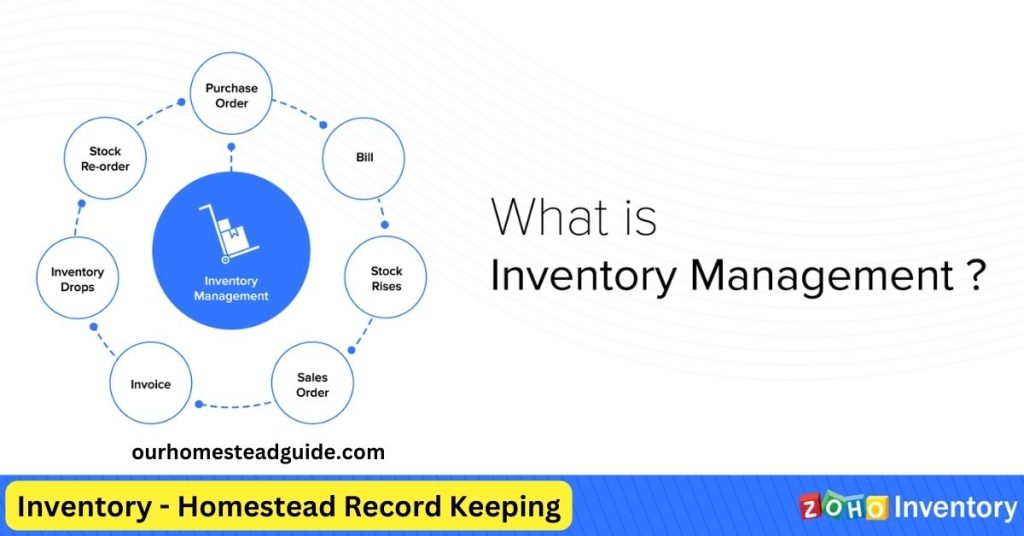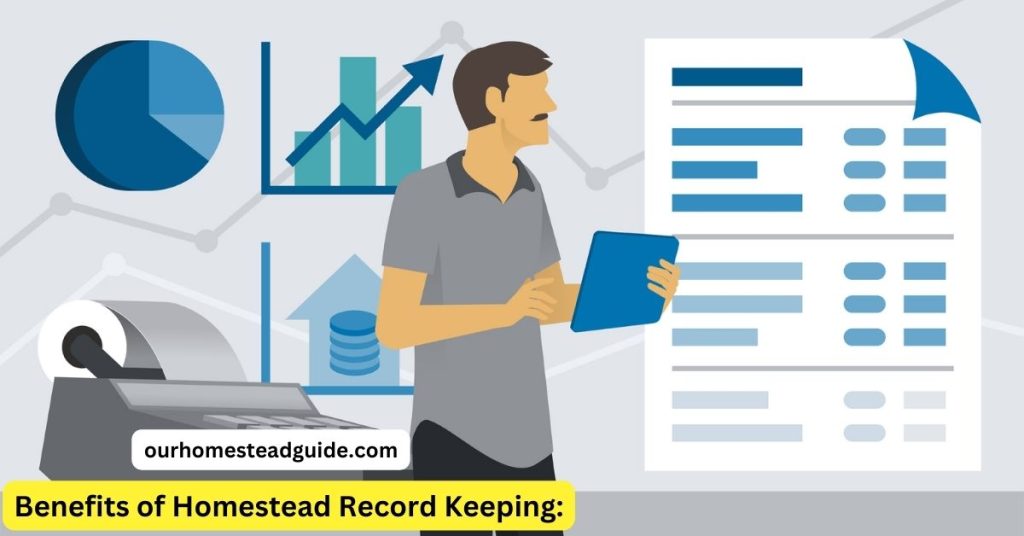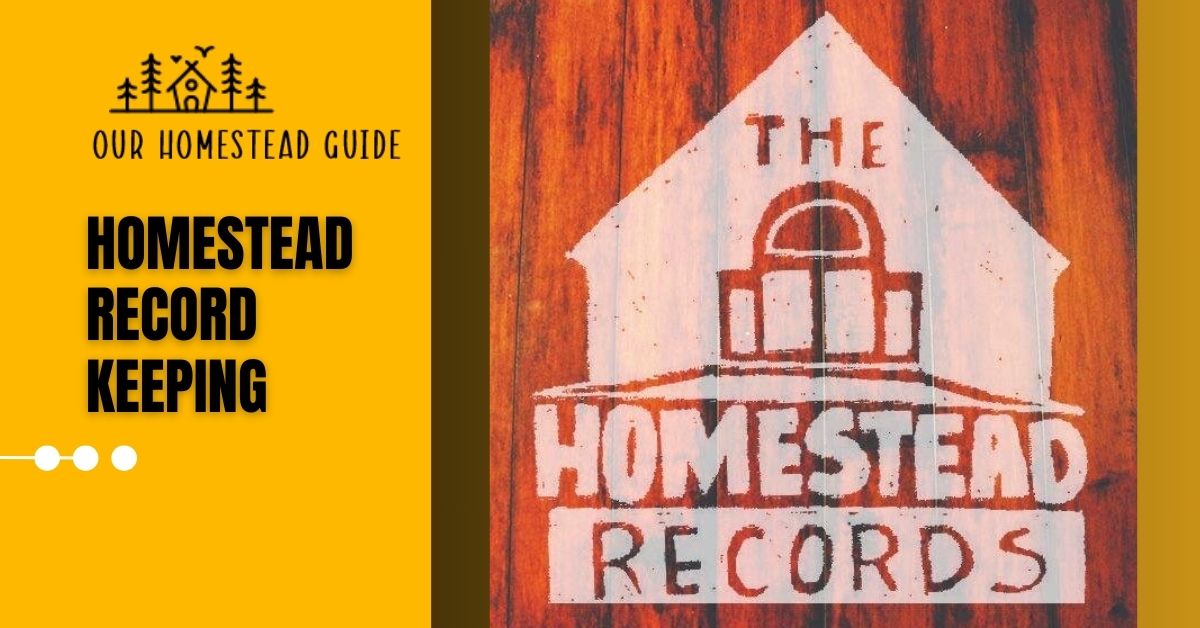Homestead Record Keeping
Homestead record-keeping is a vital practice for efficient and informed homesteading. Homesteaders may learn a great deal about consumption habits, preferences, and opportunities for improvement by closely monitoring projects including animals, gardening, and household purchases.

Utilizing tally sheets and charts, homestead record-keeping guarantees precise resource tracking for better planning. Frequent inventory inspections uncover shortages or surpluses in supplies and aid in maintaining order. All things considered, it’s an effective instrument for supporting self-sufficiency, attaining homesteading objectives, and maximizing resource management.
Homestead Record Keeping Overview

Here’s an overview of what homestead record keeping encompasses:
| Area | Description | Example Records |
|---|---|---|
| Production | Track the yield of your crops, livestock, and other produce. | * Garden harvest logs * Beehive production logs * Egg laying charts * Milk production records |
| Finances | Monitor your income and expenses related to your homestead. | * Income and expense trackers * Seed and feed purchases * Equipment costs * Sales of produce or livestock |
| Inventory | Maintain a list of your homestead’s assets, including tools, equipment, and livestock. | * Equipment inventory sheets * Seed and plant inventories * Livestock breed and lineage records |
| Maintenance | Keep track of maintenance schedules for equipment, fences, and other homestead infrastructure. | * Equipment maintenance logs * Fence repair records * Building maintenance checklists |
| Weather | Monitor and record weather patterns to inform your planting and harvesting decisions. | * Rainfall and temperature logs * Frost date records * Growing season summaries |
| Experiments | Document any experiments you conduct on your homestead, such as trying new planting methods or breeds of livestock. | * Experimental garden plots * Feed trial records * Breeding records |
Inventory – Homestead Record Keeping

Step 1: Define Your Homestead Goals
Make sure your homestead goals are clear. What goals do you have in mind? This might apply to any part of homesteading, such as cultivating vegetables or keeping hens.
Step 2: Write Down Your Goals
- Put your farm objectives on paper and post them somewhere everyone can see them, such as the office, bedroom, or barn. This supports maintaining motivation and attention.
Step 3: Start Data Collection
- Start compiling information on your homestead’s operations. To record information, using easy techniques like charts or tally marks.
Step 4: Choose Data Collection Areas
- Choose the areas of your property that you wish to monitor. The speaker uses tracking purchases in the example, mentioning things like bags of feed for the hens and eggs that the birds lay. This may be extended to other domains, such as home goods, gardening, and animal ventures.
Step 5: Use Tally Sheets for Data Collection
- Make tabulation sheets for every category you intend to monitor. For example, make a spreadsheet with columns for pint, quart, and half-pint jars if you are monitoring tomatoes. Every time you can add a tomato, you may add tally marks.
Step 6: Expand Data Collection to Other Areas
- Expand the scope of data collecting beyond animals to include other areas of your property. This might involve keeping tabs on purchases of toiletries, groceries, and other home goods.
Step 7: Reflect on Your Data
- Review the data you’ve gathered regularly. Understanding consumption habits, preferences, and potential areas of over- or under-estimation of requirements are all aided by this.
Step 8: Implement Inventory Checks
- Check inventory periodically—perhaps once a year. Determining utilization patterns entails counting the products you have on hand and comparing it to your original count.
Step 9: Purge and Reorganize
- Make use of the time between inventory checks to tidy and arrange your homestead supplies. To make tracking simpler in the future, get rid of any expired items and rearrange.
Step 10: Implement Consistent Tracking
- Continue to gather data consistently. Keep track of each acquisition and usage of goods as they occur. By doing this, you can be confident that your records are correct and current.
Step 11: Use Data for Planning
- Make use of the gathered information to schedule the next household tasks. For instance, you may design your garden based on how much tomatoes your family eats.
Step 12: Apply Data to Homestead Economics
- Think about the financial benefits of homesteading. Seek for chances to buy in bulk or take advantage of specials to save money, then modify your plans appropriately.
Step 13: Keep Records in Visible Places
- For easy access, post tally sheets or charts in conspicuous locations, such as inside cabinet doors. This facilitates quick record updating and promotes consistent tracking.
Step 14: Adapt and Evolve Your System
- Adjust your record-keeping method to reflect the growth and changes of your homestead. It ought to change to accommodate your homestead’s growing demands.
Step 15: Share and Educate Others
- Share the records with your partners or family members if they are part of your homesteading adventure, and inform them of the advantages of collecting data consistently. This guarantees that everyone is in agreement.
Benefits of Homestead Record Keeping:

Better decision-making: You may choose what to grow, raise, or invest in more wisely with the aid of data-driven insights.
Enhanced productivity: Determine where you can make time and productivity improvements on your farm.
Financial tracking: Keep an eye on your earnings and outlays to make sure the homestead can support itself.
Tax preparation: For taxation purposes, maintain correct records.
Establishing and monitoring goals: Set objectives for your homestead and monitor your advancement over time.
Exchanging information: To help other homesteaders, write down the lessons you’ve learned from your experiences.
The easiest method to maintain and one that you will use often is the ideal record-keeping setup for your farm. Select a system based on your interests and requirements, and don’t be scared to try different things until you figure out what works best for you.
Recall that maintaining accurate records is essential to benefiting from this worthwhile activity. When you set aside time every week or month to update your records, you’ll be astounded by the newfound understanding of your homestead’s growth.
What work is being done with the records?
The goal of a project undertaken by Homestead National Historical Park since 1999 is to eventually digitize all 30 million papers in the collection of Homestead case files. Together, Fold3.com, FamilySearch, the University of Nebraska–Lincoln, and Homestead National Historical Park are working to digitize every Homestead Land Entry Case File kept at the National Archives.

Over 800,000 Homestead Records from over 200 land offices in all 30 Homesteading States are to be digitalized as part of the Homestead Records Project. The first set of records to be digitally completed were those from Nebraska. Only twenty states are now available for download; the remaining ten are only available in hard copy at the National Archives.
How can I find Homestead Records?
In the heart of Washington, D.C., the National Archives houses all land-entry case files. To do a free search for homestead records (up to 1908) related to homesteads in Alaska, Arizona, Indiana, Illinois, Iowa, Nebraska, Nevada, Ohio, Wyoming, and/or Utah, visit the Heritage Center.
Additionally, you may use your computer to look up digital homestead documents on Fold3.com and Ancestry.com. However, these sites demand subscriptions to access their premium data. The General Land Office Records webpage of the Bureau of Land Management provides patent information for every state.
For any homestead established after 1908 or any state that has not embraced digitalization, you must seek documents from the National Archives. Find out more about requesting homestead records.
We encourage you to join us this holiday season when you’re #ParkedAtHome and enjoy some fun learning how to locate Homestead Land Records around the research computer. These documents may assist find out whether the homesteaders that bear the same name as your favorite holiday characters. These archived documents offer an insight into the homestead lifestyle of your vacation character twin.
What can I learn from the records?
Extensive land records were produced as a result of the documentation that homesteaders had to submit in order to receive a patent, or title, to a portion of the public domain. The land has been improved, and these documents detail the building of dwellings, the digging of wells, the planting of crops, the removal of trees, and the construction of fences.
Family members who resided on the land are mentioned in a few case files. A date of death and an explanation of relationships are provided if the claimant passed away and a widow or heirs finished the homesteading procedure.
Information about military service is occasionally supplied since it may shorten the residence requirement. A resident alien’s place of origin was occasionally given, and they disclosed details about their citizenship process to those who had proclaimed their intention to become citizens. Stated differently, homesteaders’ land-entry case files provide a valuable resource for genealogy research.
Most Frequently Asked Questions!
Why is Homestead Record Keeping important for homesteaders?
For homesteaders to keep track of their costs, income, and significant activities, record-keeping is essential. It supports effective resource management, well-informed decision-making, and regulatory compliance.
What records should homesteaders keep?
Financial accounts, purchase and spending receipts, inventory records, production logs, and other property-related legal paperwork are all necessary documentation for homesteaders.
How long should homestead records be retained?
Homestead documents may be retained for a different amount of time, although it’s usually advised to maintain financial records for three to seven years. For as long as you hold the property, you should retain any relevant legal documentation.
Do I need to keep records for tax purposes?
Indeed, maintaining correct records is necessary for filing taxes. It ensures compliance with tax requirements by assisting in the precise calculation of income, costs, and deductions.
What is considered a deductible expense for homesteaders?
Costs associated with upkeep of the land, farming operations, home office expenditures, and specific agricultural equipment may all be deductible for homesteaders. To find out whether exact deductions apply to you, it’s important to speak with a tax expert.
How can I organize my homestead records efficiently?
Think about utilizing a system that suits your needs, such as specialist farm management software, spreadsheets, or accounting software. To streamline the organization, divide data into categories like as income, spending, inventory, and legal papers.
Are there any government programs or incentives for homesteaders related to record-keeping?
Certain government programs or incentives may need certain record-keeping to be eligible, depending on where you live. For pertinent information, look into regional agricultural initiatives and speak with agricultural extension agencies.
What should I do if I make a mistake in my records?
It’s critical to make the necessary corrections as soon as you find an error. Maintain a record of the adjustments you make, and get advice from a tax expert to handle any possible ramifications if the error includes money transactions.
you may also like this article.
Homestead Photography: Different Tips for Wildlife Photography



